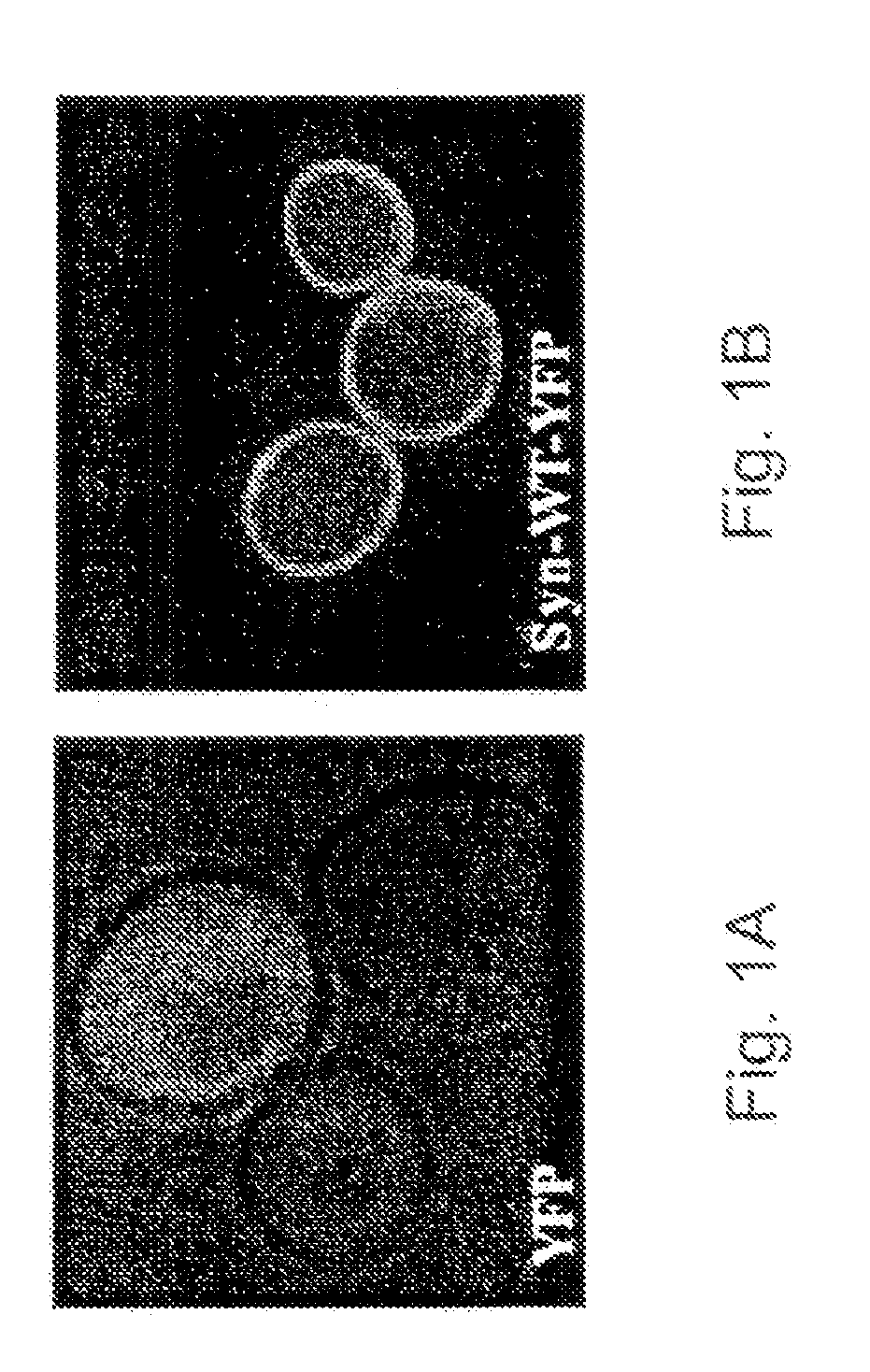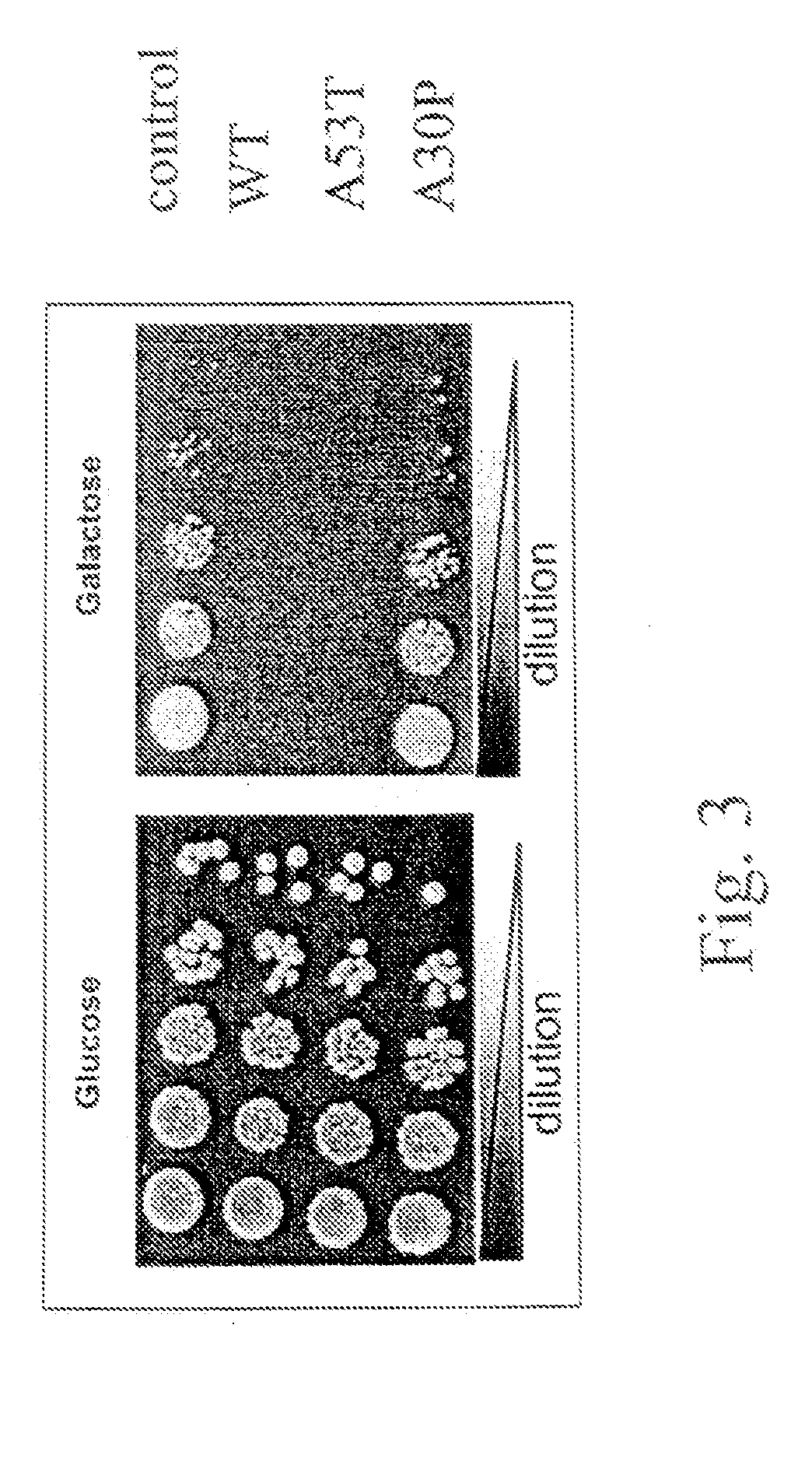Yeast ectopically expressing abnormally processed proteins and uses therefor
a technology ectopically expressed proteins, which is applied in the field of abnormally processed proteins ectopically, can solve the problems of toxicity to cells, abnormal distribution within cells, and accumulation in cells,
- Summary
- Abstract
- Description
- Claims
- Application Information
AI Technical Summary
Benefits of technology
Problems solved by technology
Method used
Image
Examples
example 1
Formation of Intracellular Inclusion and Amyloid Fibers
[0143]Alpha-synuclein has the property of forming intracellular inclusions in neurons and forming amyloid fibers in vitro. Deposition of insoluble fibril proteins in tissues is a characteristic of diseases associated with protein misfolding. Most common of these diseases are neurodegenerative diseases (e.g., Parkinson's disease, Alzheimer's disease, Huntington's disease, and prion diseases), and other diseases such as type 2 diabetes. Agents that can prevent protein aggregation and fibril formation are being actively sought. However, methods of identifying such agents are limited.
[0144]Both wildtype aS and the A53T and A30P mutants form amyloid fibers, but biochemical and cell biological properties of these proteins differ. In a purified system, the A53T mutant fibrilizes faster than the A30P mutant and wildtype aS protein, whereas the A30P mutant forms an oligomeric species faster (Conway K A, et al., 2000. Proc Natl Acad Sci U...
example 2
Inhibition of Phospholipase D (PLD)
[0147]Alpha synuclein was recently identified as a potent and selective inhibitor of mammalian phospholipase D2 (PLD2) (Jenco J M, et al., 1998. Biochemistry. 37:4901-9). Purified native PLD2 enzyme from mouse brain and recombinant PLD2 was employed in reconstitution assays to identify modulators of PLD activity. A mixture of alpha synuclein and beta-synuclein (bS) was discovered to be a potent inhibitor of PLD2 activity but not of PLD1. Providing a possible functional context, PLD activation is directly involved in membrane trafficking (Ktistakis N T, et al., 1996. J Cell Biol. 134:295-306) and cytoskeletal reorganization (Cross M J, et al., 1996. Gun Biol. 6:588-97). Specifically, PLD is thought to function in regulating vesicular movement either by activating a downstream effector essential for trafficking and / or by altering the local structural characteristics of membranes (Pertile P, et al., 1995. J Biol Chem. 270:5130-5). Moreover, there appe...
example 3
Studies of Membrane Association
[0148]When the WT and A53T proteins are expressed at a low level, clear association membrane association is observed. The experiment of FIGS. 1A-1B employed fusions of aS with YFP (yellow FP). Similar results were obtained with GFP, and CFP (Cyan FP) fusion. This suggests that even though a yeast cell differs from a human neuron in several major ways, it still provides the necessary environment for aS to localize in a normal manner.
PUM
| Property | Measurement | Unit |
|---|---|---|
| diameter | aaaaa | aaaaa |
| temperature | aaaaa | aaaaa |
| fluorescent | aaaaa | aaaaa |
Abstract
Description
Claims
Application Information
 Login to View More
Login to View More - R&D
- Intellectual Property
- Life Sciences
- Materials
- Tech Scout
- Unparalleled Data Quality
- Higher Quality Content
- 60% Fewer Hallucinations
Browse by: Latest US Patents, China's latest patents, Technical Efficacy Thesaurus, Application Domain, Technology Topic, Popular Technical Reports.
© 2025 PatSnap. All rights reserved.Legal|Privacy policy|Modern Slavery Act Transparency Statement|Sitemap|About US| Contact US: help@patsnap.com



